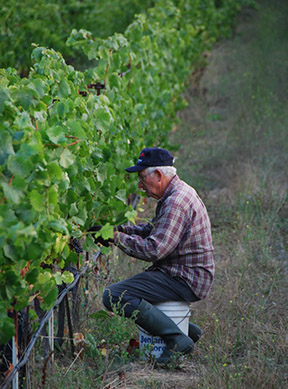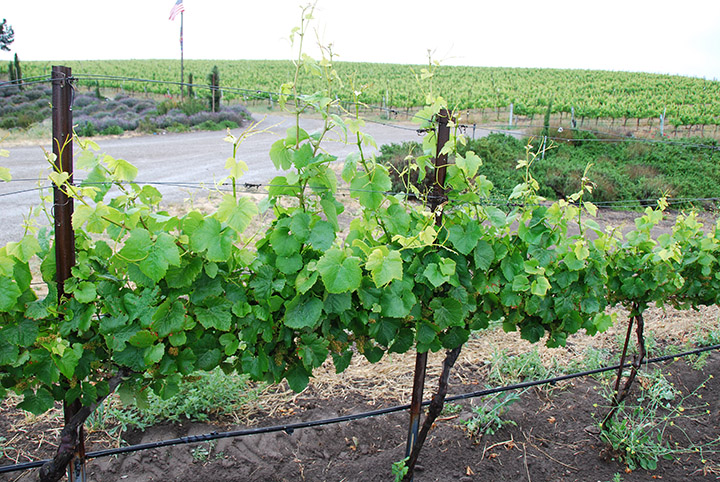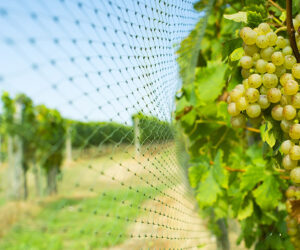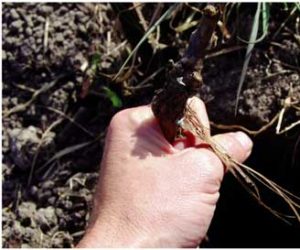
If winter vine pruning is the foundation for an entire year of winegrowing, then canopy management is the structure on which we build a quality vintage in future bottles of fine wine. I am (in)famous for saying that growing vines and making wines at home is only worth the Herculean effort if the wine is of commercial, or at least quaffable, quality. Pruning is a hard subject to write about — it’s like describing a golf swing or trying to teach someone to knit without yarn and needles. You have to be there, you need equipment in your hand and a good teacher by your side.
Canopy management is a bit different, though. We can describe and define specific practices by ratios, measurements, and by using wine quality as the final determination of our successes and failures. Today’s article is very specific: How our winegrape canopies (the canopy is the growing shoots, laterals, fruit, leaves, and tendrils before lignification or shoots becoming brown canes) influence the quality and balance of our fruit, and later, our wine. So put on your thinking cap and join me out in the “vineyard of the mind” to help define our plan for this summer’s vineyard practices to create improved canopy management.
Canopy Management Defined
For my own professional career in vineyard management, I have used Dr. Richard Smart’s early 1990s publication Sunlight Into Wine as my bible (it costs $100, but the money you will save in improving your wine when you buy and follow this book makes it a bargain).
It can’t be overstated how much this book moved the needle for winegrape growing worldwide, and I would argue no other publication since Pasteur’s Studies in Fermentation (1876) has improved wine in such a profound manner. Here is Dr. Smart’s own definition of canopy management: “Canopy management practices have three main objectives: 1) maximizing sunlight interception; 2) minimizing shading; and 3) balanced growth.”1
Before we look at a review of summer management of the vineyard to improve wine quality, let’s make sure we understand Smart’s objectives in a clear and distinct manner.
1. Maximizing sunlight interception. This has three meanings, each vital to the function of the vine and wine quality. Leaves intercept PAR (photosynthetically active radiation) and create carbohydrates for growth, and then after fruit set/bunch closure, sugar to sweeten the fruit. But beyond the leaves photosynthesizing, sunlight flecking on the fruit destroys vegetal aromas and flavors (pyrazines) and encourages floral character in whites, and high-toned fruit character in reds (terpenes). And to finish off the trifecta of turning sunlight into wine (and a balanced vine), sun activates emerging buds on this year’s shoots to be fruitful next year. Galileo was correct 500 years ago: “Wine is sunlight held together by water.” And Smart reflects this truth in the name of his book.
2. Minimizing shading. Shade doesn’t help a vine much. Perhaps to protect clusters from the sun during the hottest hours of a heat spike, but fruit that never sees sun flecking or even direct sunlight in cooler areas, will produce thin, colorless, soulless wine that will taste of olive juice and green bell pepper (pyrazines). Sunlight on the fruit also improves the color of red wine, as the berries darken with compounds like anthocyanin, to work like sunblock, to protect the fruit from burning and raisining. This is an excellent moment to warn against leaving every cluster completely exposed through leaf-pulling in spring/summer. Only 10% sun flecking throughout the day on clusters is necessary to remove vegetal character in fruit and begin encouraging floral and high-toned berry flavor in wine. So while we want the vine’s canopy to be fully exposed to sun, the clusters should be at least 10% exposed to sun flecking during the day, and we can up the leaf-plucking to find the perfect amount to expose the fruit, but not burn it. Most vineyardists take a decade to dial this in — so go slow, protect the fruit, but see how much sunlight is safe to allow into the fruiting zone.
3. Balanced growth. This one is complicated. But let’s simplify, and you can buy Smart’s book to get the more complicated concepts. I want to use two of Smart’s ratios to define balanced canopy growth: Leaf-to-cluster ratio and vine yield-to-pruning weight. From Dr. Smart again: “The ratio of yield to pruning weight, also known as the Ravaz Index, is a measure of vine balance. It’s calculated by dividing the yield at harvest by the pruning weight in the following dormant season. A ratio of 5 to 10 is generally considered ideal.
“Pruning weight is an indicator of vegetative growth, and is proportional to leaf area and shoot length. The average cane weight, which is calculated by dividing the pruning weight by the number of canes, is an indicator of shoot vigor. Smart viticulture’s golden rule is to leave 12 to 16 buds per pound of pruning weight. This ratio can be adjusted based on the vineyard’s climate, variety, and other factors.
“The Ravaz Index has been linked to fruit quality, particularly sugar and anthocyanin levels. Vineyards with high vigor have low yield pruning weight values, while overcropped vines have high values.”
The other ratio: Leaf-to-cluster, is much simpler. In a balanced vineyard, you should see a ratio of 12–15 leaves per cluster on every vine, every cultivar. (I like 15:1 in large clustered varieties like Grenache or Cabernet, and closer to 12 for smaller clusters like the Pinot family.)
Now that we have a clear idea of the theory, let’s put it into practice in your vineyard this summer!
A Schedule of Winegrape Growing Practices in Summer
Caveat: Some climates are warmer/colder than others, and these practices are broken down by an expectation of a Continental climate — cold winters, warming springs, and generally hot summers. Variations in soil, rainfall, humidity, and pest and disease pressure will require us to look at these suggested events, applications, and labors with the ability to recognize when they are appropriate, and I will do my best to describe them in a way that will allow for a tweaking of timing for appropriate use in your locale.
June:
Vines appear: Approaching full canopy, flowering is likely complete or almost complete. Grapes appear as hard, green peas and will finish lag phase soon and start growing to final size.
What to watch for: Mildew/rot — make sure the fruit zone has been leaf-plucked to an appropriate level of sun flecking to improve fruit flavors, but not too exposed to burn fruit in a heat spike. Tendrils should stop growing and the vine’s growing tips should become equal in length to the tendrils. Vines should be healthy, green, but leaves shouldn’t be larger than your hand or shiny green (too vigorous).
What to do: One last pass to spray for mildew — I would use a good dousing of stylet oil or a synthetic, and not sulfur (which can get trapped at bunch closure). Petiole sampling should have been completed at first bloom, and results can be used to fine-tune fertilization, but only if required. Keep weeds from touching the vines. Do a suckering pass to remove any basal shoots (on the trunk, for example), and put together your leaf and cluster counts to check your ratio. If there are too many leaves, adjust/remove lateral shoots. Experienced growers can go light on the water at the end of flowering until berry-set to reduce size of berries and increase skin-to-juice ratio for more intense wine and color.
Canopy management: Tidy up leaf plucking and shoot positioning, fine-tune watering schedule according to soil type and rainfall.

July:
Vines appear: Healthy, green canopy with minimal yellowing or browning. We usually see fruit softening/color changing in vines, known as veraison, which means the vines have stopped growing (vegetative growth cycle) and begun the fruit-ripening cycle.
What to watch for: After veraison, at about 19 °Brix, mildew is usually not able to grow on clusters. Some rots can still affect the grapes and vine, so keep an eye out and see what is allowed locally for sprays that won’t make your wine taste bad. Watch for birds and net your vines as the fruit softens and changes color.
What to do: If the vines are overly vigorous, hedge them back into a 12–15:1 leaf-to-cluster ratio, and also to keep the shoots from flopping over and shading the fruit zone. Watering in arid regions is important, so keep the water on to keep the vine in balance. Another few passes in the vineyard to check nets, fruit health, water status, a few leaves to be plucked or laterals to remove, keep weeds away from the vine row. Order your fermentation supplies, barrels, etc. Prepare to bottle last year’s wine to make room for fermentations. Check your harvest materials: Clippers, buckets, cotton gloves, etc. Assess pest pressure (from ants/bees/wasps, to birds, deer, pigs, etc.) Protect the fruit in the dog days of summer!
August:
Vines appear: Mostly green, but there might be a few leaves and vines that will start to show early signs of yellowing, especially on the vineyard margins. Vines that have turned bright colors already are likely virused, and if they are struggling to ripen, I recommend yanking the affected vine and replanting. Fruit should be colored up and soft, and birds are watching hungrily. Fruit zone should be open enough for sun/wind to move through, but also protected enough not to burn in a heat wave. The vine rows are clean and navigable for harvest, weeds are in check, fruit and vines are clean — we are in the end game, preparing for a successful harvest and fermentation.
What to watch for: Bird and insect damage, as well as other furry pests. Clusters lagging way too long to turn color/soften (remove the last few percent). Watch weather reports to anticipate watering needs and potentially damaging weather. Vines that are out of balance that require some work; if you see highly virused (red) vines, you might want to mark them with a special colored vinyl tape or a sign that will remind you to remove and replace them next spring.
What to do: Initiate your first fruit sampling and testing by the end of August — see what your Brix (sugars) and pH look like. If you take notes on your field sampling, compare them to previous years and use those experiences to plan and schedule when harvest might start and what preparation is needed in the vineyard and winery. Anticipate pickers in your field: Keep the vine rows clear from tall weeds and watch for gopher/squirrel burrows or other hazards that might cause injury. Start making a plan for harvest labor — friends and teenagers are the cheapest, but they don’t work too hard. Watch the weather and dream of mild sunshine.
The Golden Rules of Canopy Management
Let’s wrap this up with the bullet points:
• 10%+ sun exposure on clusters: Pull as many leaves away from the fruit as you can without the chance of serious sunburn during periods of heat. An open fruit zone will also make applications of fungicide much more effective, especially contact materials like stylet oil.
• Pull leaves just after flowering/set: Plan your first leaf-plucking run (both sides, but leave a few more leaves on the afternoon side of the canopy), as close to the finishing of flowering/set as possible. Getting sun on those tiny little set grapes is key for the development of early pre-color compounds, and the ability for the berries to take a bit of hot sun later without burning. I like to leave a “sombrero leaf” above most clusters to protect the cluster against the hottest part of the day, but allow early morning and late evening sun to fleck and filter through.
• An open canopy decreases pests, rot, and mildew, and increases wine quality.
• Lateral shoots in a proper canopy should be less than 10–20% of leaf area. Pull as many lateral shoots as you can — they clog up the canopy and have no fruit. A lateral shoot is a shoot that comes off a main shoot and has a growing tip. Cleaning out laterals allows more sun penetration into the fruit zone and opens up the middle of the vine’s canopy for wind movement, which lowers mildew/rot pressure.
• Vines should keep 1:1 ratio of vine height/canopy to row width.
• 12–15 leaves per cluster is balance in any vineyard!
That’s it! Always feel free to reach out and check in: [email protected]
References:
1 Smart, R. “Care of Established Vineyards (PDF),” South African Journal of Enology and Viticulture, Vol. 11, 1990. www.shorturl.at/ebDpD






